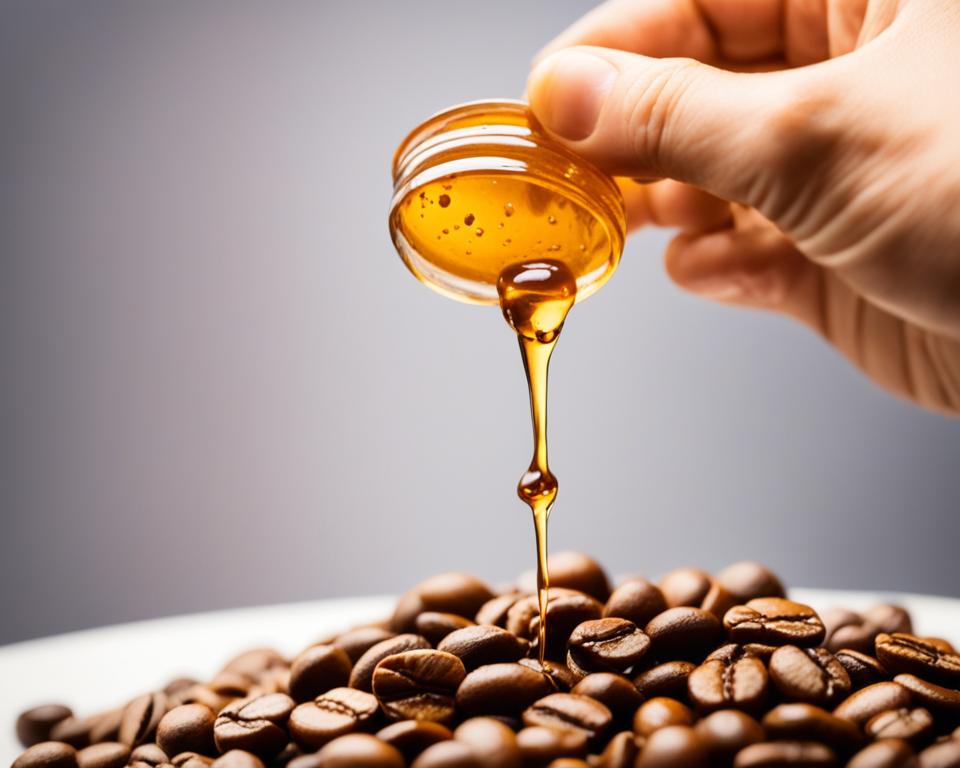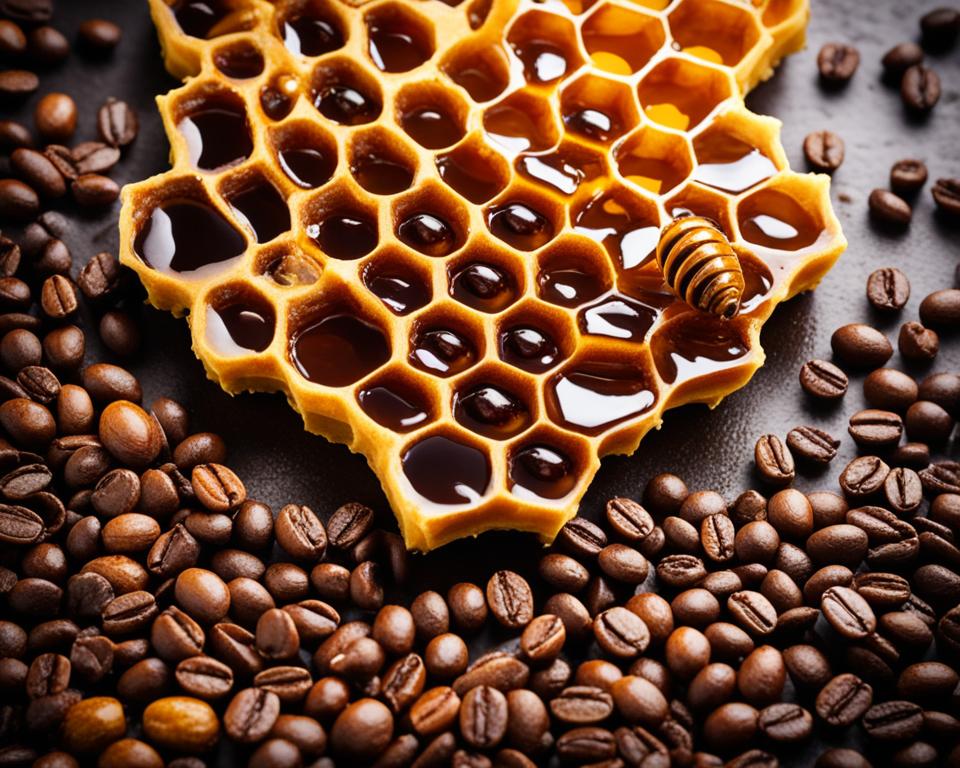Jump to Recipe
Have you ever wondered why some specialty coffees possess a richer, sweeter flavor than others? If you’re a fan of artisanal coffee brewing methods, you’ll be intrigued by honey-processed coffee.
This method surprises and delights by bringing out natural coffee flavors. Imagine sipping on a cup that perfectly balances sweetness and a silky finish, quite different from your typical brew.
In this journey, I’ll uncover how honey processing can dramatically enhance your coffee experience. Let’s dive into the world where taste meets craftsmanship.
What is honey-processed coffee?
If you enjoy exploring different coffee flavors as much as I do, you’ll find the world of honey-processed coffee fascinating. This coffee, also known as the pulp-natural process, is a semi-washed coffee method.
This unique procedure sets it apart from more common methods like full-wash and natural processes.
You might wonder, What exactly happens in honey processing? Well, let me explain. It all starts with the coffee cherry. “In this method, farmers remove the cherry’s skin but leave the mucilage, a sticky honey-like layer, on the beans.
This mucilage contains sugars and moisture, which play a significant role in developing the coffee’s final flavor profile. The beans are then dried with this mucilage intact, allowing natural fermentation to occur.

This process results in a cup of coffee that boasts milder acidity combined with a pronounced and distinct sweetness. The term “honey processed” might make you think there’s honey added to the beans. Interestingly, no honey is used
. The name derives from the honey-like texture of the mucilage that envelops the beans during drying.
The semi-washed coffee achieved through this coffee provides a unique balance between the clean flavors of washed coffee and the fruity notes found in natural process beans.
This blending of characteristics is why honey-processed coffee is gaining popularity among coffee aficionados. Have you tried it yet? If not, you’re in for a treat!
History of Honey-Processed Coffee
The journey to honey-processed coffee began in Central America. This method emerged as a brilliant coffee processing innovation, driven by the need to conserve water. The environmental and economic benefits led to its widespread adoption.
The Origin of the Process
This coffee was first developed by farmers in Costa Rica. These innovators aimed to create a method that used less water than traditional washing. The result was a unique technique combining elements of both wet and dry processing, making it stand out among historical coffee methods.
Evolution Over Time
Since its inception, the honey process has evolved significantly. Initially, there was just one way to do it, but over time, variations emerged. Farmers began experimenting, leaving different amounts of mucilage on the beans.
This led to the creation of Yellow, Red, and Black Honey processes, each producing distinct flavor profiles. This incremental evolution showcases the constant innovation in coffee processing aimed at enhancing taste and efficiency.
Impact on Coffee Culture
The honey process has undeniably made its mark on coffee industry trends. By allowing farmers to offer a unique product, it has opened doors to specialty markets.
Enthusiasts appreciate the rich flavors and the sustainable practices behind this coffee. This method has reshaped how we experience coffee, making it a staple in the culture of connoisseurs worldwide.
How It’s Made: The Honey Processing Method
Ever wondered how honey-processed coffee gets its unique flavor? Let’s take a closer look at this fascinating method. As a fan of craft coffee production, I find it incredibly interesting!
Step-by-Step Guide
The honey processing method begins with picking the ripest coffee cherries. These cherries are then de-pulped, but this leaves a layer of mucilage on the beans. Next, the beans are spread onto drying beds.
The drying period can be anywhere between 7 and 10 days. During this time, the beans need constant turning and monitoring to ensure uniform drying.
The process is part of what makes craft coffee production so special. The mucilage breaks down through a natural bean fermentation process, adding a distinct flavor to the coffee.
Key Differences from Other Methods
Have you ever tasted both washed and naturally processed coffee? You’ll notice that this coffee strikes a balance between the two. Washed coffee may lack mucilage-related flavors, while naturally processed coffee often has a fruity taste
Honey-processed coffee captures the best of both worlds, making it a favorite among those who appreciate rich and balanced flavors.
This method also aligns well with sustainable coffee production practices. Because it requires fewer resources than washed coffee, it has a smaller environmental footprint.
Why It’s Called ‘Honey’ Processing
The name ‘honey’ in honey-processed coffee is pretty intriguing, isn’t it? It doesn’t involve any honey at all. The term comes from the appearance and feel of the beans during drying.
The mucilage on them looks golden and sticky, much like honey. This unique texture and color are a visual reminder of the natural bean fermentation process taking place.
I find it amazing how simple yet significant factors can shape the flavor of our coffee. Knowing this, I think I’ll appreciate my next cup of honey-processed coffee even more!
The Unique Flavors of Honey-Processed Coffee
Have you ever tasted a coffee that surprises your palate with sweet molasses and stone fruit notes? Honey-processed coffee stands out with its remarkable flavor profile.
During coffee tastings, I often find myself captivated by its unique characteristics, which differ greatly from those of other premium coffee varieties.
The secret behind these delightful coffee-tasting notes lies in the specific drying conditions and the amount of mucilage left on the beans. This subtle, tea-like quality that this coffee brings is almost magical.
It’s no wonder why certain coffee-growing regions have adopted this method as their signature process.
Imagine sipping on a brew that effortlessly balances sweetness and complexity. That’s what you get with honey-processed coffee. Each cup showcases the best aspects of the beans, highlighting why this method is favored for premium coffee varieties
It’s like discovering a hidden treasure in each sip, and it’s hard not to fall in love with it.

Honey-Processed Coffee
Ingredients
Method
- Select Coffee Beans: Choose high-quality honey-processed coffee beans from a reputable roaster.
- Grind Beans: Grind the beans to a medium size for pour-over or fine for AeroPress, depending on your brewing method.
- Boil Water: Heat water to 195–205°F (90–96°C).
- Brew Coffee:
- For pour-over: Place the ground coffee in a filter, pour hot water slowly in a circular motion, and let it drip through.
- For AeroPress: Add the coffee grounds to the AeroPress, pour hot water, stir, and press down the plunger slowly.
- Enjoy: Pour your brewed coffee into a cup and savor the unique flavors.
Notes
Health Benefits of Honey-Processed Coffee
When it comes to the health benefits of coffee, this coffee surely stands out. This brewing method preserves essential nutrients and enhances the overall experience.
Nutritional Content
One major factor is its rich nutritional content. Honey-processed coffee provides a good dose of natural health products, including vitamins, minerals, and essential compounds. These elements support overall well-being.
Antioxidant Properties
Another noteworthy benefit is its abundance of antioxidants. As an antioxidant-rich food, honey-processed coffee contains chlorogenic acid, which is known for combating free radicals.
This property plays a crucial role in promoting heart health and reducing inflammation.
Lesser-known Perks
What many might not know is that the slow fermentation process involved in this method retains more beneficial compounds. This not only enhances the unique flavors but also boosts its health benefits. So, enjoying a cup of honey-processed coffee means savoring both taste and health advantages!
Where to Buy and How to Brew Honey-Processed Coffee
As a coffee lover, you’re in for a treat with honey-processed coffee. This specialty coffee boasts unique flavors and can be found at various artisanal roasters and specialty coffee retailers.
These vendors often emphasize direct trade and sustainable practices, ensuring the highest quality beans. A few top picks are Intelligentsia Coffee, Blue Bottle, and Stumptown Coffee Roasters.
They not only offer incredible honey-processed coffee but also provide detailed tasting notes to guide your purchase.
Once you get your hands on these beans, brewing this coffee requires a bit of attention to detail. To bring out its inherent sweetness and complex flavors, consider using methods like pour-over or AeroPress.
Coffee connoisseurs often recommend a medium grind size for pour-over and a fine grind for AeroPress.
- Grind: Use a medium grind for pour-over or a fine grind for AeroPress.
- Measure: Aim for a coffee-to-water ratio of about 1:15.
- Heat Water: Heat water to 195–205°F. Temperature control is crucial for extracting the right flavors.
- Brew: Use a slow, consistent pour for pour-over or follow standard AeroPress instructions.
Remember, experimenting with grind size and extraction time can have a huge impact on the final taste. Enjoy your brewing process; it’s part of your journey as a coffee enthusiast!
How Does the Sweetness of Honey-Processed Coffee Complement a Cafe Bombon?
The sweetness of honey-processed coffee enhances every sip of a cafe bombon, creating a delightful experience. This unique flavor profile blends harmoniously, making it the perfect pairing for those seeking a special treat. Discover the delightful notes with the deliciously sweet cafe bombon recipe revealed, your taste buds will thank you!
Conclusion
Honey-processed coffee is more than just a unique coffee style; it’s a celebration of coffee innovation. Its distinctive sweetness and layered flavors reflect a harmonious blend of tradition and modern techniques. As I savor each sip, I can’t help but marvel at the careful craftsmanship that goes into every step of the honey processing method.
Furthermore, the commitment to sustainable coffee cultivation among producers ensures that every cup you enjoy is good for the environment. This conscious effort not only preserves the land for future generations but also enriches the flavor profiles we experience today. I find it heartening to see such sustainable practices merging seamlessly with innovation.
For any coffee enthusiast looking to explore and appreciate nuanced flavors, this coffee offers a delectable journey. From its creation to your cup, it exemplifies the dedication to quality and passion for coffee. If you’re curious to learn more about rare coffee varieties, such as the specialty beans from Panama, I stumbled upon a gem at Session Coffee Denver. Embrace the richness and story behind every cup, and let each sip elevate your coffee ritual.
FAQ
What is honey-processed coffee?
Honey-processed coffee is a semi-washed method where the coffee cherry’s skin is removed, but some or all of the mucilage, also known as the honey-like substance, remains. The beans are then dried with this sticky layer intact, which ferments and imparts a characteristic sweetness to the final product.
How does honey-processed coffee differ from other methods?
Unlike fully washed coffee, where all mucilage is removed, or natural process coffee, where the entire cherry dries intact, honey-processed coffee retains some mucilage. This results in a milder acidity and pronounced sweetness, providing a unique flavor profile that balances the characteristics of both methods.
What flavors can I expect from honey-processed coffee?
The flavors of honey-processed coffee often include sweet molasses, stone fruit, and a subtle tea-like quality. The degree of sweetness and nuances depend largely on the amount of mucilage left on the beans and specific drying conditions.
What’s the history behind honey-processed coffee?
Honey processing originated in Central America, driven by the need to innovate and conserve water. Over time, this method has evolved, with varying levels of mucilage left on the beans, ranging from yellow to black honey. It’s become a popular technique among specialty coffee enthusiasts and farmers aiming to differentiate their products.
How is honey-processed coffee made?
In honey processing, coffee cherries are depulped, and the beans, still covered in mucilage, are spread onto drying beds. The drying process, which takes around 7–10 days, requires constant monitoring and turning to ensure even drying. This method combines elements of both washed and natural processing to create its distinctive flavor profile.
Why is it called “honey” processing?
The name ‘honey’ comes from the sticky appearance and texture of the beans during drying, which resemble honey. This name highlights the mucilage’s role in the unique fermentation process and resulting flavor.
Is there any health benefit to drinking honey-processed coffee?
Yes, honey-processed coffee is known for its high antioxidant content, especially chlorogenic acid, which can combat free radicals. The slow fermentation during processing may help retain more beneficial compounds, making it a delightful and healthy beverage choice.
Where can I buy honey-processed coffee?
You can purchase honey-processed coffee from artisanal roasters or specialty coffee retailers that prioritize direct trade and sustainable practices. It’s increasingly available as its popularity grows among coffee connoisseurs.
What’s the best way to brew honey-processed coffee?
To highlight the inherent sweetness of honey-processed coffee, consider brewing methods like pour-over or AeroPress, which can emphasize the distinct flavors. Pay attention to grind size and extraction time to achieve the best results.




